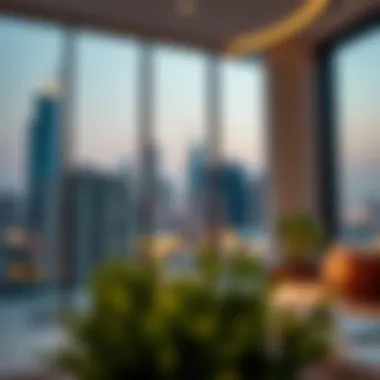Connecting Minds: The Future of Dubai Real Estate


Intro
Dubai's real estate landscape is more than just a collection of buildings and developments; it is a vibrant tapestry woven from the threads of collaboration and innovation. With the city positioned as a global hub for commerce, culture, and tourism, understanding the intricate dynamics that fuel its real estate sector is essential for investors, developers, and real estate enthusiasts. This article explores how collective intelligence shapes market trends, influences architectural advancements, and drives investment strategies. As we delve into these themes, we aim to provide key insights and actionable strategies tailored for navigating the competitive Dubai real estate market.
In the past few years, Dubai's property market has witnessed transformative changes influenced by technological advancements and an influx of diverse populations. These shifts not only create new opportunities but also present challenges. To appreciate the future trajectory of this sector, it is crucial to identify current property trends and their implications for investment strategies. This exploration will guide stakeholders in making informed decisions and understanding potential future developments.
By focusing on key insights and practical tips, readers will find themselves equipped with the knowledge necessary to tap into the potential that awaits in this ever-evolving marketplace.
Intro to Dubai's Real Estate Landscape
Dubai's real estate market stands as a fascinating blend of rapid growth and innovative practices. The city, known for its skyscrapers and luxury lifestyle, has evolved into a significant player in the global property market. Understanding this landscape is crucial for stakeholders, ranging from investors to homeowners, as it outlines opportunities and challenges within this dynamic sector.
The Evolution of Dubai's Property Market
The story of Dubai's property market is akin to a rollercoaster ride; it has been marked by dramatic highs and lows. In the early 2000s, Dubai opened its doors to foreign investors, setting the stage for exponential developments. Neighborhoods like Dubai Marina and Downtown Dubai blossomed, transforming the skyline and lifestyle of the city. The introduction of freehold property laws in 2002 catalyzed a rush, inviting myriad global investors eager to stake their claim in this desert metropolis.
However, like any market, it hasn’t been without its downturns. The global financial crisis of 2008 rocked the boat, leading to significant drops in property prices and uncovering vulnerabilities in development practices. Lessons were learned, and over the last decade, the market has redirected its focus on sustainability and long-term viability. Now, developers are mindful of the need for responsible growth, ensuring environmental concerns are addressed while still meeting demand. The shake-ups have made room for projects focused on community living and innovation.
Today, the landscape is dotted with new concepts like mixed-use developments. Buyers increasingly seek properties that don't just provide living space but also contribute to their quality of life.
Key Players in Real Estate Development
Navigating Dubai’s intricate real estate ecosystem requires understanding its key players. Among these, prominent developers such as Emaar Properties, Damac Properties, and Nakheel stand out. They have spearheaded landmark projects that reflect not just architectural grandeur but also the aspirations of a diverse clientele.
Investors:
Investors range from individual local buyers to institutional giants looking to capitalize on market trends. Their impacts can't be understated; their preferences guide the direction and kinds of developments being pursued. For instance, a growing interest in affordable housing has led some developers to pivot their strategies in response.
Architects and Designers:
A vital group are the architects and designers who bring visionary ideas to life. They work hand-in-hand with developers to ensure that projects meet both aesthetic and functional needs. Innovations in design often push the boundaries, leading to more thoughtful urban planning, where green spaces and community areas are becoming just as essential as luxury amenities.
Regulatory Bodies:
Regulatory entities like the Dubai Land Department play a critical role in the market. Their regulations affect property laws, rental standards, and investor protection measures, ensuring that the market remains stable and secure for both buyers and sellers.
Each of these players influences the market’s direction and creates an environment ripe for innovation and collaboration. As the city gears up for a future intertwined with advanced technologies and sustainable practices, these stakeholders will continue to be instrumental in shaping Dubai's real estate narrative.
The Importance of Connection in Real Estate
In the ever-evolving world of real estate, particularly in a vibrant market like Dubai, the significance of connection cannot be overemphasized. Connections can often be the thin line that separates success from failure. They allow property professionals, investors, and developers to forge partnerships, share valuable insights, and navigate the intricate landscape of the market more effectively. The relationships built through networking and collaboration serve as the lifeboat when navigating the sometimes choppy waters of real estate ventures.
Networking among Property Professionals
Networking is a fundamental pillar in the real estate industry. It goes beyond simply exchanging business cards at events; it’s about cultivating relationships that stand the test of time. In Dubai’s real estate market, where the pace is brisk and the stakes are high, knowing the right people can open doors to otherwise unreachable opportunities. Imagine a scenario where a developer stumbles upon a prime piece of land simply because they were at the right place, having a casual chat with a local agent. This illustrates the essence of informal networks that often yield significant rewards.
Within these interactions, it’s crucial to have a strategy. Professionals in real estate must actively engage in industry events, seminars, and discussions. Building a persona in social circles can provide insights that are not available through formal channels. Engaging in communities such as the Dubai Land Department or participating in forums on platforms like Reddit can also enhance one’s visibility.
Connections not only help in finding potential buyers or investors but also play a vital role in gathering market intelligence. For instance, understanding market trends from peers can significantly impact investment decisions. Moreover, leveraging social media can enable agents and developers to share experiences, hear different perspectives, and even crowdsource solutions to common challenges.
Collaborative Ventures: Benefits and Risks
While collaboration is beneficial, it’s essential to tread lightly; partnerships in real estate are often a double-edged sword. Working with others can lead to innovative solutions and shared resources, which is particularly advantageous in a competitive market like Dubai. Think about a developer joining forces with an architect to create a sustainable housing project. Each brings their own expertise, leading to a project that is both aesthetically pleasing and environmentally responsible.
However, collaboration also comes with its fair share of risks. Misaligned goals or differences in vision can sabotage a partnership before it even begins. It’s vital to have clear agreements and expectations in writing to avoid misunderstandings down the line. Additionally, relying too heavily on others can lead to potential loss of control over key decisions; after all, too many cooks can spoil the broth.


Setting boundaries within a collaborative effort is key. Maintaining open lines of communication is imperative, as is establishing trust amongst all parties involved. Ultimately, the right collaborative relationship can yield innovative projects that push the boundaries of what’s possible in Dubai’s real estate landscape. Just like any other venture, doing your due diligence before diving in is a non-negotiable step.
"Good connections in real estate can be the golden ticket to unlocking new opportunities, yet they require work, regular maintenance and trust."
By focusing on networking and collaboration, investors and property professionals can harness collective intelligence to affect change in the marketplace. This approach fosters not only personal growth but also contributes to elevating the entire sector in Dubai, making it a more robust and innovative market.
Innovative Practices in Real Estate
Innovative practices in real estate are increasingly becoming the backbone of successful property development. In a vibrant market like Dubai, where the sands of time shift rapidly, staying ahead means adapting to change with agility and foresight. Innovative strategies not only cater to the demands of modern consumers but also boost sustainability, creating a harmonious balance between profit and responsibility. Every brick laid in this city is a story waiting to unfold, and these stories thrive best in environments that foster creativity and technological advancement.
Sustainability in Property Development
Sustainability in property development is no longer just a buzzword; it’s a necessity. In an era where climate change is at the forefront of global discussions, Dubai is taking strides to lead by example. Developers are increasingly employing eco-friendly building materials, focusing on energy efficiency, and investing in renewable energy sources. This approach not only minimizes ecological impact, but also appeals to environmentally-conscious buyers.
For instance, developments like The Sustainable City are showcasing how integrated urban planning can morph into a livable, green oasis. Built with sustainability at its core, this community features solar panels, electric vehicle charging stations, and even urban farming. Beyond the environmental benefits, sustainable properties often bring down operational costs in the long run, offering a win-win for investors and residents alike.
"A focus on sustainability is like planting seeds for a better tomorrow—both in terms of urban living and fiscal health of investments."
One significant consideration, however, is the initial investment costs. Emphasizing sustainability can lead to higher upfront expenses, which can be a sticking point for some developers. Yet, with proper planning and execution, aiming for sustainability can yield substantial returns, both socially and financially. Investors must assess long-term benefits against short-term expenses, weighing the values of green initiatives against traditional methods.
Technological Integration: Smart Homes and Cities
The integration of technology in real estate—specifically the emergence of smart homes and cities—has redefined living environments in Dubai. Today’s homebuyers are looking for features beyond four walls; they desire connectivity, efficiency, and a seamless blend of technology into their daily lives. Incorporating elements such as smart lighting, security systems, and climate controls into residential spaces not only elevates comfort but enhances security and energy efficiency.
Take Dubai Silicon Oasis as an example. This area is not just a tech hub; it’s a proof-of-concept for integrated living, where advanced technology meets urban design. From intelligent traffic management systems to smart irrigation for green spaces, the vision is clear: leveraging technology to create sustainable urban living.
The potential for technological integration is vast, yet developers must also be mindful of privacy concerns and data security. As homes become increasingly connected, potential risks arise relating to personal data exposure. Investing in robust technologies that protect residents’ information is paramount.
In finality, as the Dubai real estate landscape continues to evolve, innovation remains a key driver. By prioritizing sustainability through smart planning and technological advancements, the real estate sector can address the needs of a modernizing audience while setting the stage for a prosperous and responsible future.
Market Trends Shaping the Future
In the ever-evolving landscape of Dubai real estate, staying ahead means more than just keeping an eye on property prices. It’s about understanding the market trends that not only shape the present but also sculpt the future. Investors and developers alike must navigate through the currents of change, where demand and neighborhood dynamics dictate opportunities and strategies. Hence, grasping these trends becomes paramount for anyone looking to thrive in this competitive environment.
Current Demand and Property Value Fluctuations
The pulse of the Dubai real estate market can be measured in two ways: current demand and the fluctuations of property values. In recent years, the demand for properties has shown a noticeable shift, largely influenced by various socio-economic factors. Increased interest from foreign investors, coupled with the rise of remote work trends, has opened doors to the luxury segment. Properties that boast modern amenities or unique architectural designs are more sought after than ever.
Several key factors contribute to this growing demand:
- Market Recovery Post-Pandemic: Following uncertainties brought by global events, the market has seen a revival. The pent-up demand for luxurious living spaces or investment properties has started to balance supply and demand.
- New Developments: Areas like Dubai Creek Harbour and Mohammed Bin Rashid City have caught the eye of buyers, indicating robust interest in emerging neighborhoods.
- Affordable Housing Initiatives: Local policies focusing on affordable housing for middle-income groups are reshaping the landscape. These initiatives make ownership more attainable, thus boosting demand overall.
However, property values are not static; they are constantly influenced by external factors. Economic conditions—like inflation rates, global oil prices, and employment stats—play significant roles in value shifts. For instance, a slight increase in interest rates can dampen buyers' enthusiasm, driving values down temporarily.
"Understanding demand and property value dynamics is like reading the winds; it helps investors navigate the seas of Dubai's real estate market successfully."
Emerging Neighborhoods and Investment Opportunities
As Dubai continues to expand, newer neighborhoods are sprouting up and transforming into vibrant investment hubs. Areas previously considered underdeveloped are now witnessing rapid growth, presenting lucrative opportunities for savvy investors. Here are a few neighborhoods making waves:
- Dubai South: Home to the Expo 2020 site, this area is projected to become a bustling residential and commercial center.
- Nad Al Sheba: Known for its family-friendly vibe, this neighborhood is fast becoming popular among those looking for spacious homes close to the heart of Dubai.
- Dubai Marina: Although developed for some time, it remains a hotspot due to its lifestyle appeal and proximity to business districts.
Investors should keep an eye on upcoming projects and planning initiatives.
Benefits to these emerging neighborhoods include:
- Potential for High Returns: Investing early in such areas could reap significant rewards as demand grows and infrastructure improves.
- Government Support: Many of these districts benefit from Dubai's vision to enhance urban living, garnering support that can translate into better amenities and services.
- Evolving Market Trends: Shifts towards sustainable living or community-focused projects are increasingly attractive to buyers, meaning areas that integrate these aspects may enjoy heightened value appreciation.


Navigating these trends doesn’t just require market knowledge; it demands a keen understanding of community needs and governmental strategies too. Thus, investors must be prepared to adapt their approaches dynamically as these trends evolve.
The Role of Government Initiatives
The landscape of Dubai's real estate sector has been significantly shaped by various government initiatives. These programs serve as a backbone, reflecting not only a vision for the future but also a strategy to stimulate economic growth while enhancing the livability of the city. Understanding the role of government initiatives is crucial for investors, developers, and homeowners, as these factors can determine overall market stability and growth prospects.
One of the primary ways in which the government impacts the real estate scene is through a well-defined regulatory framework. This structure consists of laws, policies, and guidelines that govern property transactions and development procedures. It lays down the groundwork that ensures transparency, protects stakeholders, and promotes a conducive investment environment. The clear delineation of regulatory expectations fosters trust, which is essential for attracting both domestic and international investors.
Furthermore, the government often plays a vital role in promoting foreign investment in Dubai's real estate market. It does this by implementing attractive visa policies, various tax incentives, and streamlined processes that facilitate easier incorporation of foreign capital into local ventures. This concerted effort is a game changer as it not only diversifies investment sources but also fuels competition and innovation in the market.
"Dubai has firmly established itself as a global hub for real estate investment, thanks largely to its progressive governmental policies that encourage growth and sustainability."
Regulatory Framework and Its Impact
The regulatory framework governing Dubai's real estate sector includes a variety of ordinances and regulations that are both robust and dynamic. The Dubai Land Department is instrumental in establishing these rules. By ensuring a clear title of ownership, registering properties, and safeguarding buyers' rights, it has bolstered investor confidence.
Some key aspects of this framework are:
- Transparency: Every transaction is recorded and monitored. This decreases the chances of disputes and fraud.
- Standardization: Regulations ensure that developers adhere to a defined building code, guaranteeing quality and safety standards.
- Incentives: By offering various tax exemptions, the government promotes commercial activities and stimulates the real estate market.
The impact of these regulations has been overwhelmingly positive. Over the years, they have led to a steady increase in property values and a diversified portfolio of investment opportunities. For instance, the introduction of the Freehold Property Law in 2002 allowed foreign nationals to own property, significantly boosting demand and encouraging multi-national developments.
Promoting Foreign Investment in Dubai's Real Estate
The government's commitment to promoting foreign investment is evident through initiatives aimed at making Dubai a welcoming destination for overseas buyers and businesses. Various strategies are in place:
- Golden Visa Program: This permits long-term residency to investors who meet specific financial criteria, thereby opening doors for foreign nationals to engage deeply in the property market.
- Low Property Taxes: By maintaining a low tax rate, Dubai positions itself favorably compared to other global cities, attracting wealth from all corners of the world.
- Government-backed Projects: Initiatives like the Dubai Urban Master Plan and Expo 2020 have showcased the city on an international stage, drawing attention from potential investors eager to capitalize on promising projects.
These efforts have resulted in a rising trend noticed in foreign investment inflows within the real estate market. Reports indicate that certain neighborhoods in Dubai have experienced substantial growth, influenced considerably by international buyers looking for lucrative opportunities.
Interdisciplinary Collaboration in Urban Planning
Urban planning in Dubai is a complex endeavor, where the confluence of multiple disciplines plays a critical role in developing sustainable and innovative living environments. By integrating various fields—architecture, environmental science, sociology, and economics—planners are better equipped to address the unique challenges posed by rapid urbanization.
In a city like Dubai, where the skyline is marked by striking modern architecture, the need for interdisciplinary collaboration has never been greater. This approach not only fosters creativity but also enhances the effectiveness of urban solutions. Planners can leverage diverse perspectives to create more inclusive and environmentally-friendly developments, ultimately benefiting the entire community.
Architecture and Sustainability: Bridging Two Fields
Sustainability in architecture often hinges on collaboration between architects and environmental scientists. This synergy is essential, as architects must consider not only aesthetic value but also the ecological impact of their designs. When architects and environmental professionals work hand-in-hand, they can design buildings that minimize resource consumption and enhance energy efficiency.
A prime example of this collaboration can be seen in Masdar City, an initiative that aims to create the world’s most sustainable urban environment. In this project, architects employed renewable energy sources, advanced water management systems, and sustainable materials. Such integrations lead not only to lower operating costs for future inhabitants but also contribute positively to the overall environment. This dual concern for beauty and sustainability shapes neighborhoods that stand the test of time, enhancing their allure for years to come.
Incorporating Community Feedback in Development
Engaging the community in the planning process is another crucial aspect of interdisciplinary collaboration. Developers and planners should actively seek input from local residents, as they hold the most insight into their own needs, desires, and cultural context. This practice leads to more relevant and appreciated developments, which strengthens community ties.
One effective means of gathering feedback is through focused group discussions and public forums, which let residents voice their thoughts in a structured setting. Using digital platforms for surveys is also becoming more common, particularly among younger demographics. By capitalizing on social media channels and apps, developers can engage with diverse segments of the population.
Community involvement not only results in better project outcomes but also cultivates a sense of ownership and pride among residents. When people feel valued in their environment, it fosters community dynamics that can enhance overall lifestyle quality.
In sum, the future of Dubai’s urban landscape heavily relies on the collaborative efforts across several disciplines. The combination of architecture and sustainability, alongside community feedback, underscores a framework that prioritizes the needs of all stakeholders involved. As we move toward advancing urban living solutions, this interdisciplinary approach will become a cornerstone in shaping the city’s future.
Challenges Facing the Dubai Real Estate Market
Navigating the Dubai real estate market, while full of opportunities, is not without its challenges. The landscape is constantly evolving; thus understanding these hurdles is crucial for investors, developers, and homeowners alike. Economic fluctuations, infrastructure demands, and regulatory changes can all significantly impact property values and investment strategies. Addressing these challenges is essential not just for individual success in the market, but also for the overall health and sustainability of Dubai's property sector.
Economic Conditions and Their Influence


Economic factors are the backbone of any market, and Dubai's real estate scene is no exception. The local economy’s performance can either bolster property prices or trigger declines. For instance, global economic downturns can lead to reduced foreign investment, which has been a key driver in Dubai's real estate growth. Additionally, fluctuations in oil prices often cascade through the economy, affecting consumer spending and investment.
Investors need to stay attuned to shifts in economic indicators like unemployment rates, GDP growth, and consumer confidence. It is essential to recognize that what happens abroad can influence local markets. When the international community feels uncertain, it reflects in reduced transactions within Dubai's luxury property segment. As a result, stakeholders should consider hedging strategies that can mitigate risks associated with these economic swings.
"In real estate, understanding the broader economic picture is as vital as knowing the specifics of a property. Sometimes it’s not just about location, it’s about timing and understanding the larger factors at play."
Addressing Infrastructure Needs
Infrastructure is the lifeline of any burgeoning city, and Dubai is no exception. As the population expands, so does the need for utilities, roads, and public transport systems to support the influx of residents. Shortfalls in infrastructure can lead to higher costs for developers and longer timelines for project completions. Furthermore, inadequate infrastructure can decrease property appeal, affecting long-term investment returns.
Investors and developers are facing the necessity to engage closely with governmental initiatives focused on infrastructure upgrades. A proactive approach can minimize disruptions and open up new avenues for development. For example, upcoming transport links, such as the extension of the metro system or new road networks, can dramatically enhance property accessibility, justifying higher property prices. Collaborations between public entities and private developers often yield sustainable solutions to infrastructure challenges, ensuring that as the market grows, it does so on a solid foundation.
Ensuring robust infrastructure isn't just about building roads and bridges. It’s about planning communities that thrive.
In summary, grasping the economic landscape and addressing infrastructure needs are pivotal for anyone involved in Dubai's real estate market. With a blend of informed decisions and strategic foresight, stakeholders can leverage these challenges into opportunities for growth.
The Future of Dubai Living
Looking ahead, the future of living in Dubai stands at a pivotal junction, marked by the intersection of innovation, lifestyle shifts, and urban development. As one of the world's most dynamic cities, Dubai has been continually reshaping its identity to appeal to a diverse range of inhabitants. The focus isn’t just on bricks and mortar; it's about creating environments that nurture community, well-being, and sustainability.
Real estate stakeholders — from investors to developers and homeowners — need to pay heed to these evolving trends. With the rise of younger generations, lifestyle choices are shifting, demanding novel living spaces that offer more than just a place to rest one’s head at night. This encompasses vibrant neighborhoods, community-oriented spaces, and the integration of technology and sustainability in residential units. We are no longer talking simply about homes, but about lifestyles that resonate with the aspirations of modern dwellers.
Trends in Lifestyle Choices
The vibrancy of Dubai’s culture reflects in the preferences of those who call it home. Young professionals and families alike gravitate towards communities that promote a work-life balance while showcasing a blend of cosmopolitan living and authenticity.
Some notable trends include:
- Eco-conscious living: As the climate crisis pushes sustainability to the forefront, buyers are increasingly favoring properties that are energy-efficient or built using sustainable materials.
- Smart homes: Integration of technology into living spaces is paramount. Homeowners are looking for properties equipped with smart appliances and energy management systems. Indeed, homes that promise lower utility bills and heightened convenience are desirable.
- Amenities-focused developments: There’s an upsurge in demand for properties that offer recreational facilities such as gyms, pools, and co-working spaces. Buyers are now seeking more than just a dwelling; they want a lifestyle that caters to comprehensive well-being.
"It's not about where you live, it's about how you live."
Anticipating Expected Developments
With the anticipated growth in the population and a rising influx of global talent, the Dubai real estate landscape is expected to evolve in significant ways. Here are a few developments to keep an eye on:
- Mixed-use developments: Properties that blend residential, commercial, and entertainment spaces are likely to gain traction. These developments will cater to urban dwellers who prefer convenience and accessibility.
- Smart city initiatives: The government is pouring resources into smart city projects. This entails the integration of advanced technology in urban infrastructure, enhancing transport, security, and daily living.
- Affordable housing: To accommodate a broader demographic, there will be a push for affordable yet high-quality housing alternatives. Addressing the snug balance between luxury and affordability remains a crucial aspect.
In sum, the future of Dubai living is not predestined; it will be sculpted by collective vision and collaboration among investors, government entities, and the community. The focus is now on fostering environments that not only attract but also retain residents, ensuring Dubai remains a global hub for living well.
Finale: Envisioning the Path Forward
As we bring this exploration of Dubai's dynamic real estate landscape to a close, it’s crucial to reflect on how the threads of collaboration and innovation weave together to shape a brighter tomorrow for the sector. In a city like Dubai, where the skyline is a testament to ambition, the future doesn’t just happen—it is created. Thus, this conclusion crystallizes the essence of connection among stakeholders, driving transformative change.
Synthesizing Insights for Stakeholders
One clear takeaway from this article is the necessity for stakeholders to synthesize insights as they navigate the complex and nuanced real estate environment. Understanding trends—whether they relate to shifts in buyer preferences or technological advancements—allows investors and developers to make informed decisions.
Such understanding isn’t finite. It evolves as markets fluctuate and consumer needs shift. For instance:
- Continuous engagement with industry trends and global marketplaces can enhance adaptability.
- Collaborative forums and workshops among professionals can foster shared learning.
"Collaboration breeds innovation; together, we can envision a resilient future."
By tapping into diverse perspectives, stakeholders can benefit from enriched strategies that not only meet current demands but also anticipate future needs. Whether it’s through attending expos, participating in local economic forums, or utilizing platforms like reddit.com for discussions, the power of knowledge remains vital.
Aligning Future Strategies with Market Trends
Aligning strategies with emergent market trends is paramount for sustainable growth and profitability. As we look to the future, it’s apparent that adaptability will be key. Developers must consider not just current trends, but also how societal shifts, such as remote work or eco-friendly living, will reshape the landscape.
- Flexible living spaces that cater to changing lifestyles are becoming increasingly sought after.
- Investors should consider residential schemes that incorporate sustainability to meet buyer demands.
Additionally, the importance of networking cannot be overstated. Engaging with local authorities and keeping abreast of regulatory frameworks can provide a competitive edge. For resources on regulations, the Dubai Land Department serves as an indispensable guide.









